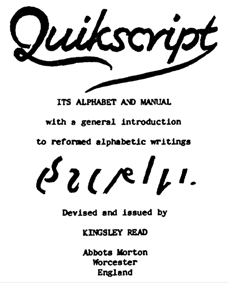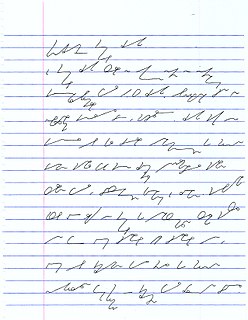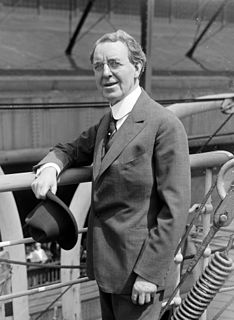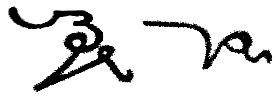
The Shavian alphabet is an alphabet conceived as a way to provide simple, phonemic orthography for the English language to replace the difficulties of conventional spelling using the Latin alphabet. It was posthumously funded by and named after Irish playwright Bernard Shaw.

Quikscript is an alphabet specifically designed for the English language. Quikscript replaces traditional English orthography, which uses the Latin alphabet, with completely new letters. It is phonemically regular, compact, and designed to be comfortably and quickly written. There are also Quikscript alphabets adapted for other languages, using the same letters for sounds which do not exist in English.

Shorthand is an abbreviated symbolic writing method that increases speed and brevity of writing as compared to longhand, a more common method of writing a language. The process of writing in shorthand is called stenography, from the Greek stenos (narrow) and graphein. It has also been called brachygraphy, from Greek brachys (short), and tachygraphy, from Greek tachys, depending on whether compression or speed of writing is the goal.
Dutton Speedwords, transcribed in Speedwords as Dutton Motez, is an international auxiliary language as well as an abbreviated writing system using the English alphabet for all the languages of the world. It was devised by Reginald J. G. Dutton (1886–1970) who initially ran a shorthand college promoting Dutton Shorthand, then offered a mail order (correspondence) self-education course in Speedwords while still supporting the Dutton Shorthand. The business was continued by his daughter Elizabeth after his death.
Pitman shorthand is a system of shorthand for the English language developed by Englishman Sir Isaac Pitman (1813–1897), who first presented it in 1837. Like most systems of shorthand, it is a phonetic system; the symbols do not represent letters, but rather sounds, and words are, for the most part, written as they are spoken.
Gregg shorthand is a form of shorthand that was invented by John Robert Gregg in 1888. Like cursive longhand, it is completely based on elliptical figures and lines that bisect them. Gregg shorthand is the most popular form of pen stenography in the United States; its Spanish adaptation is fairly popular in Latin America. With the invention of dictation machines, shorthand machines, and the practice of executives writing their own letters on their personal computers, the use of shorthand has gradually declined in the business and reporting world. However, Gregg shorthand is still in use today.

Canadian syllabic writing, or simply syllabics, is a family of writing systems used in a number of Indigenous Canadian languages of the Algonquian, Inuit, and (formerly) Athabaskan language families. These languages had no formal writing system previously. They are valued for their distinctiveness from the Latin script and for the ease with which literacy can be achieved; indeed, by the late 19th century the Cree had achieved what may have been one of the highest rates of literacy in the world.

Teeline is a shorthand system developed in 1968 by James Hill, a teacher of Pitman Shorthand. It is accepted by the National Council for the Training of Journalists, which certifies the training of journalists in the United Kingdom.
Personal Shorthand, originally known as Briefhand in the 1950s, is a completely alphabetic shorthand.

Eclectic shorthand is an English shorthand system of the 19th century. Although it has fallen into disuse, it is nonetheless noteworthy as one of the most compact systems of writing ever devised.

John Robert Gregg was an Irish educator, publisher, humanitarian, and the inventor of the eponymous shorthand system Gregg Shorthand.
In a featural writing system, the shapes of the symbols are not arbitrary but encode phonological features of the phonemes that they represent. The term featural was introduced by Geoffrey Sampson to describe the Korean alphabet and Pitman shorthand.
Speedwriting is the trademark under which three versions of a shorthand system were marketed during the 20th century. The original version was designed so that it could be written with a pen or typed on a typewriter. At the peak of its popularity, Speedwriting was taught in more than 400 vocational schools and its advertisements were ubiquitous in popular American magazines.

Bezenšek Shorthand is a shorthand system, used for rapidly recording Bulgarian speech. The system was invented by the Slovene linguist Anton Bezenšek c. 1879. It is based on the Gabelsberger shorthand, so it is often referred to as the Gabelsberger–Bezenšek Shorthand.
Forkner Shorthand is an alphabetic shorthand created by Hamden L. Forkner and first published in 1955. Its popularity grew through the 1980s as those who needed shorthand every day began to favor the easier learning curve of alphabetic systems to the more difficult symbol-based ones. Forkner was taught in high-schools and colleges throughout North America along with comparable shorthands such as AlphaHand, Speedwriting, Stenoscript and Personal Shorthand.

Deutsche Einheitskurzschrift is a German stenography system. DEK is the official shorthand system in Germany and Austria today. It is used for word-for-word recordings of debates in the Federal Parliament of Germany.
Stenoscript or Stenoscript ABC Shorthand is a shorthand system invented by Manuel C. Avancena (1923–1987) and first published in 1950. Encyclopædia Britannica, perhaps erroneously, claims the system was originally published in London in 1607. An unrelated project also called Stenoscript was written by George A.S. Oliver and published in London in 1934.

The Duployan shorthand, or Duployan stenography, was created by Father Émile Duployé in 1860 for writing French. Since then, it has been expanded and adapted for writing English, German, Spanish, Romanian, Latin, Danish, and Chinook Jargon. The Duployan stenography is classified as a geometric, alphabetic stenography and is written left-to-right in connected stenographic style. The Duployan shorthands, including Chinook writing, Pernin's Universal Phonography, Perrault's English Shorthand, the Sloan-Duployan Modern Shorthand, and Romanian stenography, were included as a single script in version 7.0 of the Unicode Standard / ISO 10646










